Author: arndxt
Compiled by: Tim, PANews
In the past few months, my stance has undergone a noticeable change:
- From extreme pessimism to bullishness (excessive pessimism often lays the groundwork for a market rebound)
- From pessimism to concerns that the macro financial market is becoming fragile.
I believe that macro volatility is not caused by a single factor, but rather due to five mutually reinforcing positive feedback phenomena:
The risk of policy missteps is rising as the Federal Reserve tightens financial conditions amid uncertainty in economic data and clear signs of slowdown.
The AI industry and tech giants are shifting from "cash-rich" to "leverage-driven growth," which shifts the nature of risk from pure stock price volatility to a more familiar debt cycle dilemma.
Private credit and loan valuations are beginning to diverge. Early signs of pressure based on model valuations have started to emerge, which is a concerning early signal.
The K-shaped economy is increasingly solidifying and gradually becoming a political issue. For more and more people, social consensus is no longer credible, and this issue will eventually be reflected in national policy.
Market concentration has become a systemic weakness. When about 40% of the index is actually controlled by a few monopolistic companies sensitive to geopolitical and leverage factors, it transcends mere growth narratives and becomes a target for national security and policy regulation.
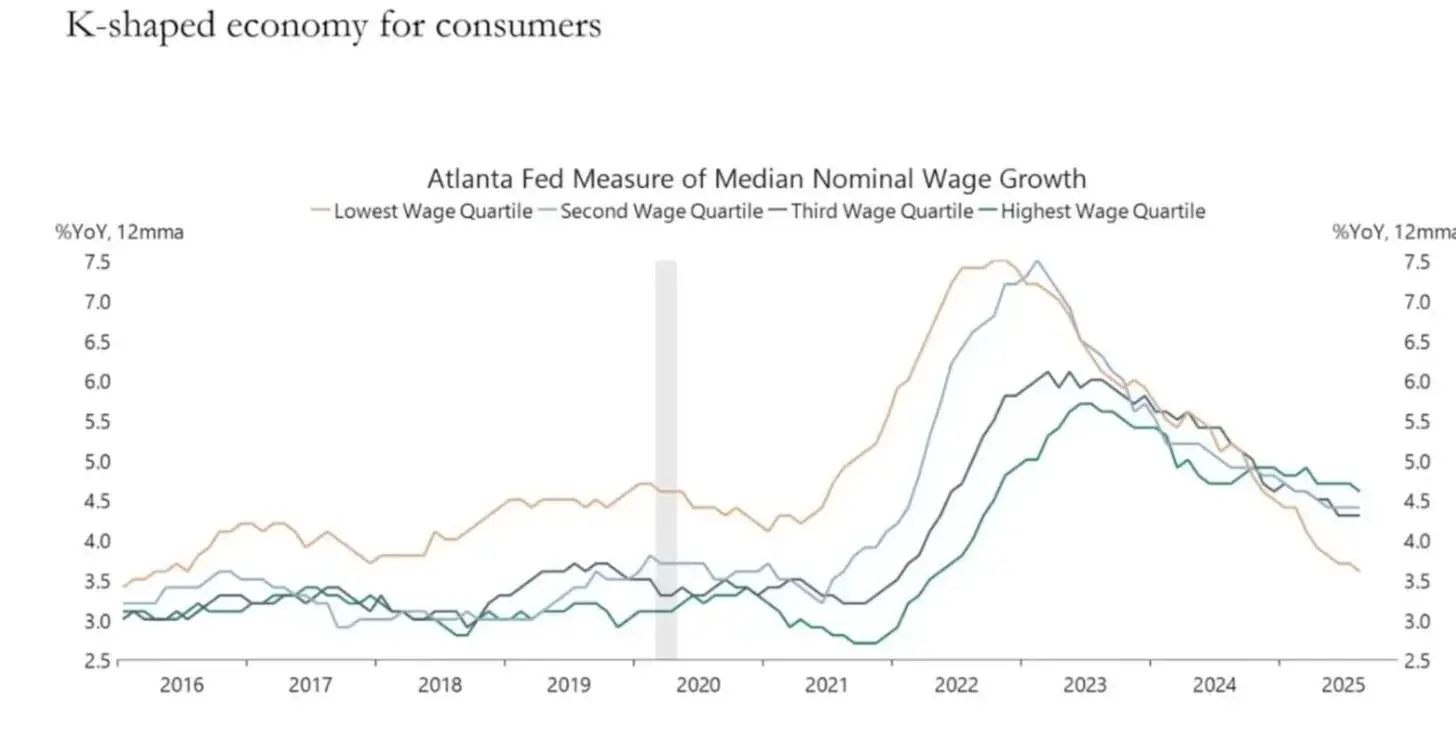
The basic assumption may still be that policymakers will ultimately "repeat the mistakes of the past": re-injecting liquidity into the financial system to support the economy by maintaining asset prices until the next political cycle.
However, unlike standard bottom-support strategies, this policy path appears more rugged: it relies more on credit-driven growth and is accompanied by more political instability factors.
1. Macro Stance
For most of the current cycle, adopting a "cautiously bearish" stance has been reasonable:
- Inflation is high but has begun to slow.
- Policy remains generally accommodative.
Risk asset valuations are high, but there is often liquidity support during pullbacks.
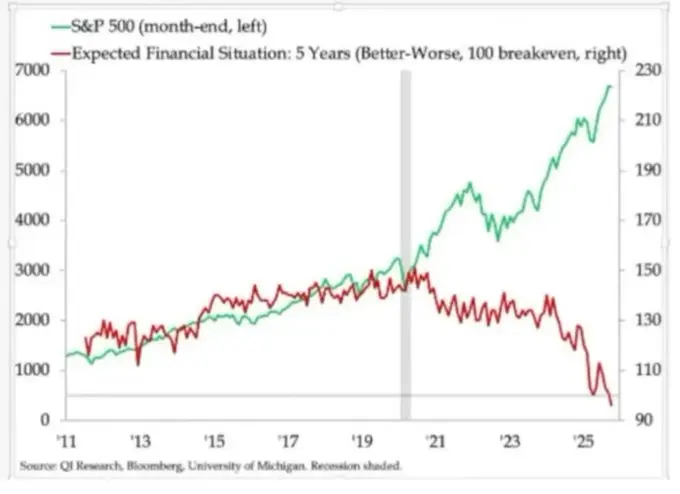
Currently, several factors have changed:
- U.S. government shutdown: We have experienced a prolonged government shutdown, disrupting the release of key macro data and affecting its credibility.
- Statistical uncertainty: Senior officials themselves admit that federal statistical agencies are in trouble, meaning that positions worth trillions of dollars are affected.
- Hawkish turn amid economic weakness: In the current context, the Federal Reserve has turned to a more hawkish policy tone in terms of interest rate expectations and its balance sheet, tightening financial conditions despite deteriorating leading indicators.
In other words, the current macro environment is tightening amid ambiguity and new pressures, rather than moving away from these risks. This constitutes a distinctly different risk landscape.
2. Policy Tightening in the Fog
The core issue is not merely about tightening policy, but about the specific areas and methods of that tightening:
- Data fog: After the government shutdown, the release of key data (inflation, employment) has been delayed, distorted, or questioned. The Federal Reserve's official "dashboard" has become unreliable at the most critical time.
- Interest rate expectations: Although leading indicators suggest inflation will continue to slow early next year, recent hawkish comments from Federal Reserve officials have led to a recalibration of market expectations for near-term rate cuts.
- Balance sheet: Even if policy rates remain unchanged, the Federal Reserve is maintaining balance sheet reduction during quantitative tightening and is inclined to transfer more long-term bonds to the private sector, which essentially tightens financial conditions.
Historically, the Federal Reserve's policy missteps often stem from poor timing: whether tightening or loosening policy, actions are often too slow.
We may repeat history: tightening policy during a slowdown with unclear data, rather than proactively loosening policy.
3. AI and Large Tech Stocks Have Shifted to Leverage-Driven Growth
The second structural shift lies in the fundamental changes of AI companies and large tech firms:
Over the past decade, the core "FANG" stocks have essentially played the role of equity assets akin to bonds: they possess dominant advantages, massive free cash flow, large-scale stock buyback programs, and manageable net leverage levels.
In the past two to three years, this free cash flow has been massively reinvested into AI capital expenditures: data centers, chips, and infrastructure.
We are now entering a new phase where incremental capital expenditures for AI are increasingly funded through debt issuance, rather than solely relying on internally generated cash flow.
Impacts:
- Credit spreads and credit default swaps (CDS) are beginning to show volatility. As leverage rises due to financing for AI infrastructure, credit spreads for companies like Oracle are widening.
- Stock volatility is no longer the only risk. In some industries previously considered "bulletproof," we are starting to see signs of a classic credit cycle.
- Market structure amplifies this risk. These companies have a disproportionately high share in major indices, and their transition from "cash cows" to "leverage growth" firms is changing the risk structure of the entire index.
This does not mean that the AI "bubble" has ended. If returns are real and sustainable, debt-financed capital expenditures are reasonable.
But it does mean that the margin for error is smaller, especially in the context of rising interest rates and tightening policies.
4. Early Fault Lines in Credit and Private Markets
Beneath the calm surface of the public markets, private credit is showing early signs of pressure:
The same loan is being marked at significantly different valuations by different management firms (for example, one at 70 cents on the dollar, another at about 90 cents on the dollar).
This divergence is a classic precursor to a battle between model pricing and market pricing.
This pattern is reminiscent of the following situations:
- 2007: Non-performing assets continued to rise, and credit spreads gradually widened, while stock indices remained relatively stable.
- 2008: Markets once considered cash equivalents (such as auction rate securities) suddenly malfunctioned.
It is also worth noting:
- The Federal Reserve's reserves have begun to decline.
- There is a growing realization within the government that some form of balance sheet expansion may be needed to prevent liquidity mechanism issues.
This does not necessarily lead to a crisis. But it aligns with the current state of the system: credit is quietly tightening, while policy remains framed within a "data-dependent" framework rather than taking proactive action.
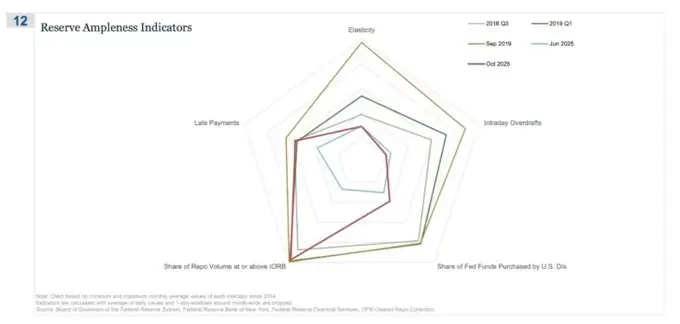
The signal that "reserves are no longer abundant" is first evident in the repo market.
In this radar chart, the "percentage of repo transactions at or above the IORB rate" is the clearest signal indicating that we are quietly exiting a truly ample reserve system.
In the third quarter of 2018 and early 2019, this pressure was still manageable: ample reserves kept the rates for most secured financing transactions stable below the IORB lower bound.
By the time of the repo market crisis in September 2019, this rate curve had clearly diverged: an increasing number of repo transactions were settling at or above the reserve balance rate, which is a typical sign of collateral and reserve scarcity.
Now looking at the comparison between June and October 2025:
The light blue line (June) remains safely within the range, but the red line for October 2025 extends outward to levels near the 2019 trend, indicating that the proportion of repo transactions approaching the policy rate bottom is rising.
In other words, as bank reserves are no longer abundant, dealers and banks are pushing up overnight financing quotes.
Combined with other radial indicators (increased intraday overdrafts, rising Federal Reserve funding purchases by U.S. deposit institutions, slight increases in delayed payments), these signs collectively convey a clear message.
5. The K-Shaped Economy is Becoming a Political Variable
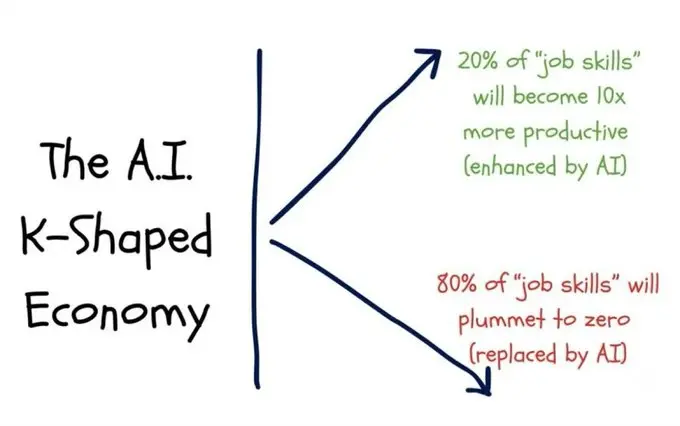
In my view, the economic divergence we have long referred to as "K-shaped" has now become a political variable.
Household expectations are polarized. Long-term financial outlooks (such as five-year expectations) show significant disparities: some groups expect stability or improvement, while others anticipate a sharp deterioration.
Reality pressure indicators are lighting up red:
- The delinquency rate for subprime auto loan borrowers is rising.
- The timing for home purchases is continually being pushed back, with the average age of first-time homebuyers nearing retirement age.
- Youth unemployment rate indicators in multiple markets are gradually climbing.

For more and more people, the current system not only exhibits "injustice" but is also trending towards dysfunction:
- They have neither asset accumulation nor wage growth, and are almost hopelessly excluded from the wealth distribution brought about by inflation.
- The widely accepted social consensus of "working hard, seeking progress, accumulating wealth, and securing" is gradually disintegrating.
In this environment, political behavior is beginning to change:
- Voters are no longer choosing the "optimal managers" of the current system.
- They are increasingly inclined to support extreme candidates from the left or right, as potential losses seem limited to them: "It can't get much worse than this."
Future tax policies, wealth redistribution, regulation, and monetary support policies will unfold against this broader backdrop.
This is by no means a typical neutral event for the market.
6. High Concentration as a Systemic Risk in Markets and Politics
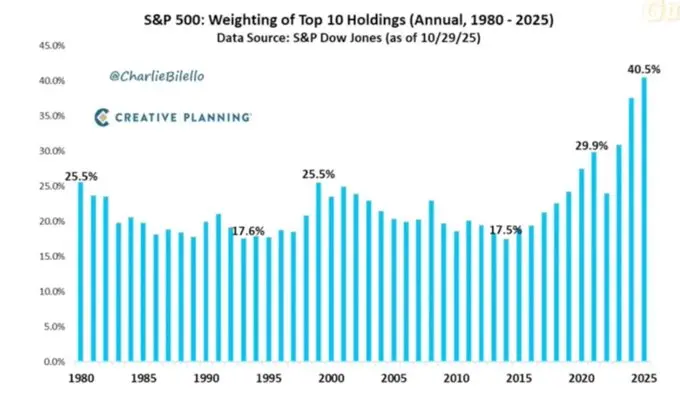
The major market capitalization of U.S. stocks is concentrated in a few companies. However, the systemic and political implications of this are rarely discussed:
Currently, the top 10 companies account for about 40% of major U.S. stock indices.
These companies share the following characteristics:
- They are core holdings in pension funds, 401(k) retirement plans, and individual investment portfolios.
- Their reliance on artificial intelligence is continuously increasing.
- They have effectively formed monopolies in multiple digital domains.
This brings about three intertwined risks:
Systemic market risk: When these leading companies face earnings, regulatory, or geopolitical shocks, the risks will rapidly transmit through the household wealth system to the entire market.
National security risk: When national wealth and productivity are overly concentrated in a few externally dependent companies, these companies become vulnerable links in national strategy.
Political risk: In an environment of economic K-shaped divergence and rising populism, these companies are likely to become focal points of social discontent, specifically manifested as
Facing higher tax rates, windfall taxes, and restrictions on stock buybacks
Under pressure for antitrust-driven breakups
Subject to strict AI and data regulatory constraints
In other words, these companies are not only growth engines but also potential targets for policy regulation, and the likelihood of the latter is increasing day by day.
7. The Failure of Bitcoin, Gold, and the "Perfect Hedge" Narrative (So Far)
In an environment intertwined with the risks of policy missteps, credit pressure, and political turmoil, one might think that Bitcoin would rise as a macro hedging tool, but the reality is quite different:
- Gold is demonstrating the characteristics of a traditional crisis hedging tool: steadily strengthening, with smooth volatility, and its allocation value in investment portfolios is becoming increasingly prominent.
- Bitcoin's trading logic is becoming more akin to Beta risk assets: highly tied to liquidity tides. It is exceptionally sensitive to leverage and structured products. Long-term holders are selling off in the current environment.
The initial narrative of decentralization and monetary revolution remains theoretically compelling, but it faces challenges in practice:
- The dominant capital flows in the current market have become highly financialized: yield strategies, derivatives trading, and shorting volatility behaviors are very common.
- Bitcoin's actual performance is closer to the Beta of tech stocks rather than a neutral, robust hedging tool.
I still believe there is a reasonable possibility that 2026 will be an important turning point for Bitcoin (the next policy cycle, the next round of stimulus measures, and a further weakening of trust in traditional assets).
However, investors should recognize that at this stage, Bitcoin has not provided the hedging attributes that many expect. It is also part of the liquidity system we are concerned about.
8. Outlook for 2026: A Viable Development Framework
A useful framework for thinking about the current environment is that this is a managed release of a bubble, aimed at making room for the next round of stimulus policies.
The script may unfold as follows:
- Mid-2024 to mid-2025: Controlled policy tightening and pressure period
- Government shutdown and political dysfunction lead to cyclical drag.
- The Federal Reserve leans hawkish in rhetoric and balance sheet operations, tightening financial conditions.
- Credit spreads moderately widen. Speculative areas (AI, long-cycle technology, some private credit) bear the brunt of the impact.
Late 2025 to 2026: Liquidity recovery and political cycle start simultaneously
As inflation expectations decline and the market adjusts, policymakers regain the space to loosen policies.
We expect to see interest rate cuts and fiscal measures aimed at supporting growth and elections introduced simultaneously.
Given the lag in policy, the effects of inflation will only become apparent after significant political milestones.
Post-2026: Financial markets face a comprehensive reassessment
The specific outcomes will depend on the scale and form of the next round of stimulus policies, and we will face two possibilities:
A new round of asset inflation cycles accompanied by more political and regulatory interventions, or a more severe confrontation with issues such as debt sustainability, market concentration, and social consensus.
This framework is not inevitable, but it aligns with the current motivations of the government:
- Politicians prioritize winning re-election over maintaining long-term stability.
- The most convenient policy tool remains releasing liquidity rather than structural reforms.
- To re-employ these tools, they first need to eliminate some of the current bubbles.
Conclusion
All signals and indicators point to the same conclusion: the financial system is entering a more fragile phase of the cycle, with a lower tolerance for error.
In fact, past history shows that policymakers will ultimately resort to large-scale liquidity stimulus as a response.
To enter the next stage, a period characterized by the following features must be experienced:
- Tightening financial conditions.
- Increased sensitivity to credit.
- Intensified political turmoil.
- And increasingly nonlinear policy responses.
免责声明:本文章仅代表作者个人观点,不代表本平台的立场和观点。本文章仅供信息分享,不构成对任何人的任何投资建议。用户与作者之间的任何争议,与本平台无关。如网页中刊载的文章或图片涉及侵权,请提供相关的权利证明和身份证明发送邮件到support@aicoin.com,本平台相关工作人员将会进行核查。




